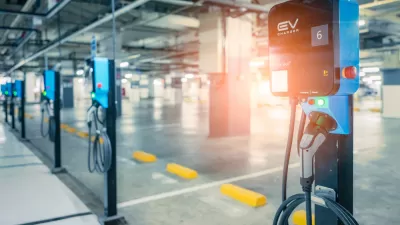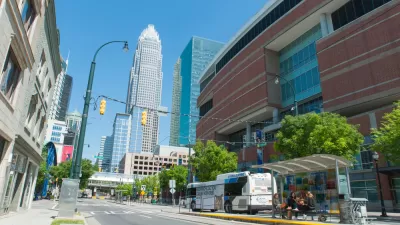The federal government is so far unwilling to reverse course on car-dependent sprawl. The Inflation Reduction Act is the latest example.

Since Congress approved the nation’s largest-ever climate action bill, the Inflation Reduction Act (IRA), a debate has raged about whether the bill will do enough to reduce greenhouse gas (GHG) emissions to meet the nation’s, and the world’s, climate goals.
As explained in an opinion piece for Metropolis magazine, the debate boils down to “Don’t make perfect the enemy of the good” versus “those who don’t learn from history are doomed to repeat it.” While think tanks like the Rhodium Group predict that the bill will significantly reduce GHG emissions in the United States, those reductions will still fall well short of the goals set by the Biden administration and the United Nations. According to the editorial, a gap remains between achievement and aspiration because of the nation’s stubborn adherence to a status quo of car-centric planning.
According to the editorial, as the IRA commits to the electric vehicle as its sole its primary tool for reducing GHG emissions from the transportation sector, it misses an opportunity to commit to the kinds of land use and transportation evolution that could actually accomplish the necessary progress toward climate stability, rather than kicking the can farther down the road.
Only a new era of design and planning will end the automobile dependence that’s at the root of this destruction. Starting with land use regulations, any effective climate action should remove strict zoning regulations that segregate residential and retail uses, enabling neighborhood-serving retail within walking distance of homes; one component of the “15-Minute City” ideal most publicly exemplified by Paris. (And found in neighborhoods in Chicago, Philadelphia, Miami, and other U.S. cities.) The federal government will also have to push local and state officials to shrink the sizes of homes, for example, by reducing minimum lot sizes and floor area requirements in zoning codes, to enable the kind of residential density that can support local economies. The “Emissions Gap Report,” published by the United Nations Environment Program in 2019, recommended a 20 percent reduction in average floor area per person.
FULL STORY: Paved With Good Intentions: We Still Can’t Kick the Car Habit

Maui's Vacation Rental Debate Turns Ugly
Verbal attacks, misinformation campaigns and fistfights plague a high-stakes debate to convert thousands of vacation rentals into long-term housing.

Planetizen Federal Action Tracker
A weekly monitor of how Trump’s orders and actions are impacting planners and planning in America.

Chicago’s Ghost Rails
Just beneath the surface of the modern city lie the remnants of its expansive early 20th-century streetcar system.

Bend, Oregon Zoning Reforms Prioritize Small-Scale Housing
The city altered its zoning code to allow multi-family housing and eliminated parking mandates citywide.

Amtrak Cutting Jobs, Funding to High-Speed Rail
The agency plans to cut 10 percent of its workforce and has confirmed it will not fund new high-speed rail projects.

LA Denies Basic Services to Unhoused Residents
The city has repeatedly failed to respond to requests for trash pickup at encampment sites, and eliminated a program that provided mobile showers and toilets.
Urban Design for Planners 1: Software Tools
This six-course series explores essential urban design concepts using open source software and equips planners with the tools they need to participate fully in the urban design process.
Planning for Universal Design
Learn the tools for implementing Universal Design in planning regulations.
planning NEXT
Appalachian Highlands Housing Partners
Mpact (founded as Rail~Volution)
City of Camden Redevelopment Agency
City of Astoria
City of Portland
City of Laramie




























